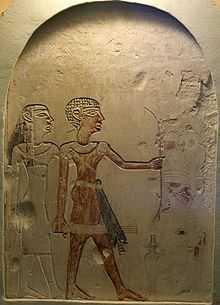Gebelein
Gebelein (also Gebelên, Jabalên;[1] Ancient Egyptian: Inerty; Greek: Pathyris or Aphroditopolis) is a town in Egypt. It is located on the Nile, about 40 km south of Thebes, in Qena Governorate.
The modern geographic area is known as Naga el-Gherira.[2]
Archaeology

Gebelein is known for its cemetery, where archeological finds stretching from the Predynastic Period to the Middle Kingdom have been made.[3][4] Archaeological interest in the town started in the early 18th century AD and was included in Benoît de Maillet's Description de l'Egypte.[5] The site includes the remains from a temple to Hathor with a number of cartouches on mud bricks and a royal stela from the Second to Third Dynasties.
In the 160s BC, during the reign of Ptolemy VI Philometor, a military camp was established at Gebelein. The camp was destroyed by rebel forces 88 BC and the site was never again inhabited on a larger scale. Several hundred Demotic and Greek papyri and ostraca pertaining to the soldiers and the local temple were found at the ruins between 1890 and 1930. These including the archive of the mercenary Horos son of Nechoutes.
As well as official excavations, many artifacts from the site were traded on the antiquities market and can be found in the museums of Turin, Cairo, Berlin, Lyons, and the British Museum.[2]
A Pre-dynastic mummified body dated to 3400 BC, excavated from this site, has been on display in the British Museum since 1901.[6]
See also
References
- ↑ Budge, Ernest Alfred Thompson Wallis (1920), By Nile and Tigris: a narrative of journeys in Egypt and Mesopotamia on behalf of the British Museum between the years 1886 and 1913, John Murray: London, OCLC 558957855
- ↑ 2.0 2.1 Bard, Kathryn A.; Shubert, Steven Blake (1999), Encyclopedia of the archaeology of ancient Egypt, Routledge, p. 338, ISBN 978-0-415-18589-9
- ↑ "Gebelein human mummy, 3400 BC". British Museum. Retrieved 2010-06-05.
- ↑ "Cosmetic-box, Graeco-Roman". British Museum. 2010-05-14. Retrieved 2010-06-05.
- ↑ Mascrier, Jean Baptiste Le; de Maillet, Benoit (1735), Description de l'Egypte, chez Louis Genneay
- ↑ Maev Kennedy (October 14, 1987). "Ancient Egyptian given new lease of life: Maev Kennedy goes down among the dead men at the British Museum to see a mummy made up". The Guardian (London).